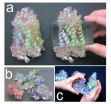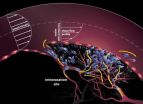(Press-News.org) Humans inherit more than three times as many mutations from their fathers as from their mothers, and mutation rates increase with the father's age but not the mother's, researchers have found in the largest study of human genetic mutations to date.
The study, based on the DNA of around 85,000 Icelanders, also calculates the rate of human mutation at high resolution, providing estimates of when human ancestors diverged from nonhuman primates. It is one of two papers published this week by the journal Nature Genetics as well as one published at Nature that shed dramatic new light on human evolution.
"Most mutations come from dad," said David Reich, professor of genetics at Harvard Medical School and a co-leader of the study. In addition to finding 3.3 paternal germline mutations for each maternal mutation, the study also found that the mutation rate in fathers doubles from age 20 to 58 but that there is no association with age in mothers — a finding that may shed light on conditions, such as autism, that correlate with the father's age.
The study's first author is James Sun, a graduate student in Reich's lab who worked with researchers from deCODE Genetics, a biopharma company based in Reykjavik, Iceland, to analyze about 2,500 short sequences of DNA taken from 85,289 Icelanders in 24,832 father-mother-child trios. The sequences, called microsatellites, vary in the number of times that they repeat, and are known to mutate at a higher rate than average places in the genome.
Reich's team identified 2,058 mutational changes, yielding a rate of mutation that suggests human and chimpanzee ancestral populations diverged between 3.7 million and 6.6 million years ago.
A second team, also based at deCODE Genetics (but not involving HMS researchers), published a paper this week in Nature on a large-scale direct estimate of the rate of single nucleotide substitutions in human genomes (a different type of mutation process), and came to largely consistent findings.
The finding complicates theories drawn from the fossil evidence. The upper bound, 6.6 million years, is less than the published date of Sahelanthropus tchadensis, a fossil that has been interpreted to be a human ancestor since the separation of chimpanzees, but is dated to around 7 million years old. The new study suggests that this fossil may be incorrectly interpreted.
Great Heights
A second study led by HMS researchers, also published in Nature Genetics this week, adds to the picture of human evolution, describing a newly observable form of recent genetic adaptation.
The team led by Joel Hirschhorn, Concordia Professor of Pediatrics and professor of genetics at Boston Children's Hospital and HMS, first asked why closely-related populations can have noticeably different average heights. David Reich also contributed to this study.
They examined genome-wide association data and found that average differences in height across Europe are partly due to genetic factors. They then showed that these genetic differences are the result of an evolutionary process that acts on variation in many genes at once. This type of evolution had been proposed to exist but had not previously been detected in humans.
Although recent human evolution is difficult to observe directly, some of its impact can be inferred by studying the human genome. In recent years, genetic studies have uncovered many examples where recent evolution has left a distinctive signature on the human genome. The clearest "footprints" of evolution have been seen in regions of DNA surrounding mutations that occurred fairly recently (typically in the last several thousand years) and confer an advantageous trait, such as resistance to malaria. Hirschhorn's team observed, for the first time in humans, a different signature of recent evolution: widespread small but consistent changes at many different places in the genome, all affecting the same trait, adult height.
"This paper offers the first proof and clear example of a new kind of human evolution for a specific trait," said Hirschhorn, who is also a senior associate member of the Broad Institute. "We provide a demonstration of how humans have been able to adapt rapidly without needing to wait for new mutations to happen, by drawing instead on the existing genetic diversity within the human population."
Average heights can differ between populations, even populations that are genetically very similar, which suggests that human height might have been evolving differently across these populations. Hirschhorn's team studied variants in the genome that are known to have small but consistent effects on height: people inheriting the "tall" version of these variants are known to be slightly taller on average than people inheriting the "short" versions of the same variants.
The researchers discovered that, in northern Europe, the "tall" versions of these variants are consistently a little more common than they are in southern Europe. The combined effects of the "tall" versions being more common can partly explain why northern Europeans are on average taller than southern Europeans. The researchers then showed that these slight differences have arisen as a result of evolution acting at many variants, and acting differently in northern than in southern Europe.
"This paper explains — at least in part — why some European populations, such as people from Sweden, are taller on average than others, such as people from Italy," Hirschhorn said.
The researchers were only able to detect this signature of evolution by using the results of recent genome-wide association studies by the GIANT consortium, which identified hundreds of different genetic variants that influence height.
###FUNDING INFORMATION
The Reich/deCODE study was supported by a Bioinformatics and Integrative Genomics PhD training grant (JXS), a Burroughs Wellcome Travel Grant (JXS), a Burroughs Wellcome Career Development Award in the Biomedical Sciences (DR), a HUSEC seed grant from Harvard University (DR), a SPARC award from the Broad Institute of Harvard and MIT (DR), National Science Foundation HOMINID grant 1032255 (DR), and National Institute of Health grant R01HG006399 (DR).
The Hirschhorn study was supported by the National Heart, Lung and Blood Institute's FHS (contract no. N01-HC-25195) and its contract with Affymetrix, Inc., for genotyping services (contract no. N02-HL-6-4278). A portion of this research used the Linux Cluster for Genetic Analysis (LinGA-II) funded by the Robert Dawson Evans Endowment of the Department of Medicine at Boston University School of Medicine and Boston Medical Center. This work was also supported by a graduate research fellowship from the National Science Foundation (to C.W.K.C.), the March of Dimes (6-FY09-507 to J.N.H.) and the National Institute of Diabetes and Digestive and Kidney Diseases (1R01DK075787 to J.N.H.).
Most mutations come from dad
New insights into age, height and sex reshape views of human evolution
2012-08-24
ELSE PRESS RELEASES FROM THIS DATE:
Survival statistics show hard fight when malignant brain tumors appear at multiple sites
2012-08-24
LOS ANGELES (Embargoed until 10 a.m. EDT on Aug. 24, 2012) – When aggressive, malignant tumors appear in more than one location in the brain, patient survival tends to be significantly shorter than when the disease starts as a single tumor, even though patients in both groups undergo virtually identical treatments, according to research at Cedars-Sinai Medical Center's Maxine Dunitz Neurosurgical Research Institute.
"We've known that certain independent factors, such as age at diagnosis, amount of residual tumor after surgery, and the patient's functional status are useful ...
Bigger creatures live longer, travel farther for a reason
2012-08-24
DURHAM, N.C. -- A long-standing mystery in biology about the longer lifespans of bigger creatures may be explained by the application of a physical law called the Constructal Law (www.constructal.org).
What this law proposes is that anything that flows -- a river, bloodstream or highway network -- will evolve toward the same basic configuration out of a need to be more efficient. And, as it turns out, that same basic law applies to all bodies in motion, be they animals or tanker trucks, says Adrian Bejan, the J.A. Jones Professor of mechanical engineering at Duke and ...
New model gives hands-on help for learning the secrets of molecules
2012-08-24
For biology researchers, the complex world of molecular proteins – where tens of thousands of atoms can comprise a single protein – may be getting clearer with the help of a new soft, transparent, and squishy silicone model they can hold in their hands. Its advantage over traditional computer and solid models is that it is mostly transparent and easy to manipulate, which will help researchers more intuitively understand protein structures, positions, and interactions. The models will enable researchers to quickly and collaboratively see, touch, and test ideas about molecular ...
Modeling metastasis
2012-08-24
Cancer metastasis, the escape and spread of primary tumor cells, is a common cause of cancer-related deaths. But metastasis remains poorly understood. Studies indicate that when a primary tumor breaks through a blood vessel wall, blood's "stickiness" tears off tumor cells the way a piece of tape tears wrapping paper. Until now, no one knew the physical forces involved in this process, the first step in metastasis. Using a statistical technique employed by animators, scientists created a new computer simulation that reveals how cancer cells enter the bloodstream. The researchers ...
The end of an era? Branding horses does not enable them to be identified
2012-08-24
There are many reasons why it is important to be able to identify farm animals, horses and small companion animals. Unique identification marks are essential for ensuring the correctness of breeding programmes, for preventing the spread of disease and for eliminating the possibility of deceit in competitions or when animals are sold. The traditional method of marking larger farm animals relies on branding with hot irons or on ear-tagging but this is deemed inappropriate for use on dogs and cats, which are identified by the implant of a microchip transponder. Until recently, ...
Astrocytes control the generation of new neurons from neural stem cells
2012-08-24
Astrocytes are cells that have many functions in the central nervous system, such as the control of neuronal synapses, blood flow, or the brain's response to neurotrauma or stroke.
Reduces brain tissue damage
Prof. Pekny's laboratory together with collaborators have earlier demonstrated that astrocytes reduce the brain tissue damage after stroke and that the integration of transplanted neural stem cells can be largely improved by modulating the activity of astrocytes.
Generation of new neurons
In their current study, the Sahlgrenska Academy researchers show how astrocytes ...
Researchers describe new molecular interactions behind the inhibition of TGF beta-signaling
2012-08-24
This press release is available in Spanish.
Researchers headed by Maria Macias an ICREA researcher at the Institute for Research in Biomedicine (IRB Barcelona) and Joan Massagué, a Howard Hughes Medical Institute investigator at Memorial Sloan-Kettering Cancer Center (MSKCC) in New York, have identified a new molecular mechanism that plays a crucial role in the control of the activation of certain genes associated with cancer.
Through detailed structural and biochemical studies, the researchers identified a key domain present in a family of proteins called Smads, whose ...
Southampton physicists join search for hidden magnetic states
2012-08-24
Physicists from the University of Southampton were among the first researchers to use the new high magnetic-field beamline at Diamond Light Source, the UK's national synchrotron facility, to search for 'hidden magnetic states'.
If found, they will provide important confirmation of a theoretical model, which could have important applications in magnetic data storage.
Diamond's new I10 Beamline for Advanced Dichroism Experiments (BLADE) beamline, which has 300,000 times the strength of the earth's magnetic field, is providing them with the tools for the search. The beamline ...
Working class prefers comedy and the intellectual class goes for drama
2012-08-24
A study enjoying Spanish participation has analysed the theatre demand of society according to the socioeconomic status of the different types of the viewing public. The results were that the theatre is not just enjoyed by the intellectual classes. While they do prefer drama, the working class opts for comedy and the wealthier are swayed by reviews.
Theatre arts are loss-making services that require subsidies to stay afloat. This type of practice has frequently come under fire as it is thought that theatre is consumed mainly by society's economic elite.
A study published ...
NASA spots heavy rainfall in Tropical Storm Isaac
2012-08-24
NASA's Tropical Rainfall Measuring Mission satellite, known as TRMM has been monitoring the rainfall rates within Tropical Storm Isaac as the storm entered the eastern Caribbean Sea.
After becoming a tropical storm in the central Atlantic on August 21, Isaac continued tracking westward and entered the eastern Caribbean early on the evening of Aug. 22 with the ill-defined center passing just south of Guadeloupe in the Leeward Islands. Since becoming a tropical storm, Isaac has shown little change in intensity, but the National Hurricane Center expects that to change ...
LAST 30 PRESS RELEASES:
Making lighter work of calculating fluid and heat flow
Normalizing blood sugar can halve heart attack risk
Lowering blood sugar cuts heart attack risk in people with prediabetes
Study links genetic variants to risk of blinding eye disease in premature infants
Non-opioid ‘pain sponge’ therapy halts cartilage degeneration and relieves chronic pain
AI can pick up cultural values by mimicking how kids learn
China’s ecological redlines offer fast track to 30 x 30 global conservation goal
Invisible indoor threats: emerging household contaminants and their growing risks to human health
Adding antibody treatment to chemo boosts outcomes for children with rare cancer
Germline pathogenic variants among women without a history of breast cancer
Tanning beds triple melanoma risk, potentially causing broad DNA damage
Unique bond identified as key to viral infection speed
Indoor tanning makes youthful skin much older on a genetic level
Mouse model sheds new light on the causes and potential solutions to human GI problems linked to muscular dystrophy
The Journal of Nuclear Medicine ahead-of-print tip sheet: December 12, 2025
Smarter tools for peering into the microscopic world
Applications open for funding to conduct research in the Kinsey Institute archives
Global measure underestimates the severity of food insecurity
Child survivors of critical illness are missing out on timely follow up care
Risk-based vs annual breast cancer screening / the WISDOM randomized clinical trial
University of Toronto launches Electric Vehicle Innovation Ontario to accelerate advanced EV technologies and build Canada’s innovation advantage
Early relapse predicts poor outcomes in aggressive blood cancer
American College of Lifestyle Medicine applauds two CMS models aligned with lifestyle medicine practice and reimbursement
Clinical trial finds cannabis use not a barrier to quitting nicotine vaping
Supplemental nutrition assistance program policies and food insecurity
Switching immune cells to “night mode” could limit damage after a heart attack, study suggests
URI-based Global RIghts Project report spotlights continued troubling trends in worldwide inhumane treatment
Neutrophils are less aggressive at night, explaining why nighttime heart attacks cause less damage than daytime events
Menopausal hormone therapy may not pose breast cancer risk for women with BRCA mutations
Mobile health tool may improve quality of life for adolescent and young adult breast cancer survivors
[Press-News.org] Most mutations come from dadNew insights into age, height and sex reshape views of human evolution





